Mallorca is very religious. This becomes quite obvious once you see the numerous churches and the majestic cathedral in Palma. But moreover, there are also a multitude of hermitages, sanctuaries, and monasteries. I’ll show you the most beautiful monasteries of Mallorca in this extensive post.
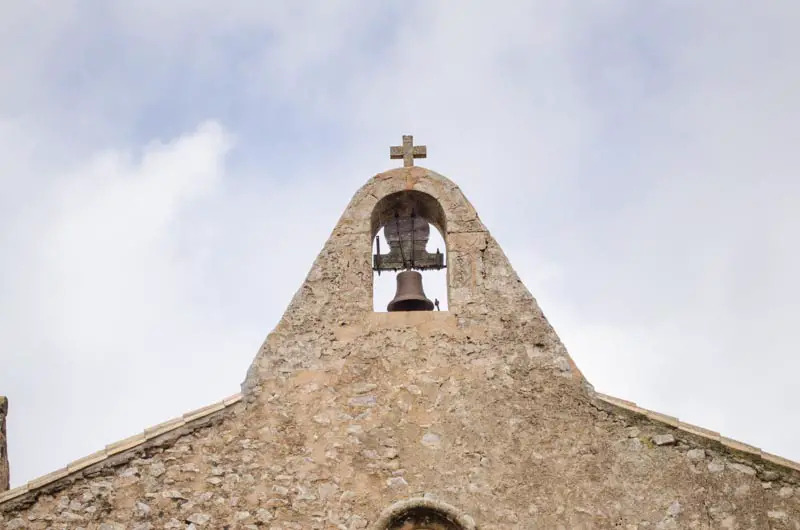
Transparency note: Some links in this post may lead to external booking opportunities. If a purchase is made, we receive a small commission. The price does not change for you.
The most famous monastery on Mallorca is undoubtedly the Sanctuary of Lluc that many of you have undoubtedly heard about. Also, I’m sure you might have heard about the monastery mountain in Randa. But besides these two famous convents, there are may more. I want to give you an overview of some of the most famous monasteries on Mallorca, and I’m going to show you quite a few hidden gems as well. Hermitages and chapels, which you can find along hiking trails, are partly in somewhat desolate conditions.
- Different kinds of monasteries in Mallorca?
- The most beautiful monasteries of Mallorca
- Hiking to the hermitages of Mallorca
- Other excursions to small hermitages
- Ermita de Bonany
- Ermita de Bellver
- Ermita Cristo Rei
- Ermita de Sa Cova de Sant Marti
- Ermita de l’Inmaculada
- Ermita de la Santísima Trinidad
- Ermita de Capdepera
- Ermita de Victoria
- Ermita de Sant Miquel
- Ermita Sant Salvador in Artà
- Ermita de Santa Llucia in Manacor
- Cova de s’Ermita Guillem
- Ermita del Calvari in Felanitx
- Hermitage Sa Mola de Tuent
- Overnight stays at the monasteries of Mallorca
- Read more
Different kinds of monasteries in Mallorca?
When I wrote this post first in German, I had to clarify the terminology. In English, this is actually not necessary, since the words exist and do mean the same. However, not everything on Mallorca, that is called a monastery, is or was one in the past. Many of the sites declared as monasteries are just hermitages, where monks pursued their spirituality in solitude and seclusion with nature. Quite often, the hermitages later became monasteries.
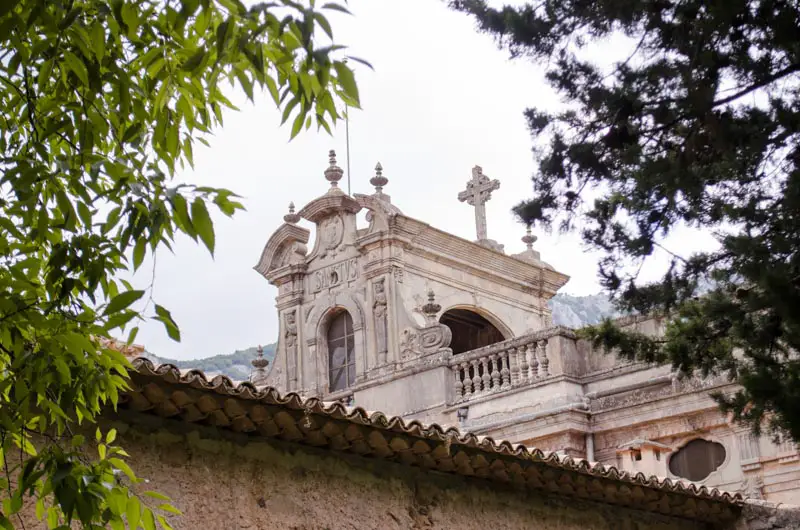
Very often, according to legends, figurines of saints were found in the mountains or forests. To honor those saints, who miraculously showed up, the people built them small sanctuaries, where the statues were kept. In the beginning, those sanctuaries were just small chapels, which later more often than not grew into different-sized monasteries. On Mallorca, the terms are often mixed. It is hardly ever easy to tell, if people refer to real monasteries or something else.
monestir / monesterio – monestery
santuari / santuario – sanctuary
ermita – hermitage
convento – active monastery
In Mallorca today, most of the monasteries no longer pursue their original purpose. Only a few active monasteries remain. As in many professions, there is a problem of new blood. The monks and nuns are getting too old to pursue their services in seclusion. That’s why more and more monasteries are being abandoned.
The most beautiful monasteries of Mallorca
As with many lists, this selection is, of course, only my opinion and purely subjective. The larger monasteries are somewhat more overrun with tourists than smaller hermitages. There are many beautiful tours and hikes to the monasteries in Mallorca, and I’ve linked to some of them. As I am still in the process of translating single posts, some linked pages might still appear in German. You can either translate them through your browser or just ignore them. However, I thought the information valuable, therefore I left the links active.
The monastery mountain of Randa (Llucmajor)
Main article: Randa Monastery Mountain in Llucmajor
The first monk to pursue spirituality in the seclusion of the mountain Puig de Randa was Ramon Llull, a polymath and founder of the written Catalan language. He lived in a cave below the Santuario de Nostra Senyora de Cura and wrote his most important work there.
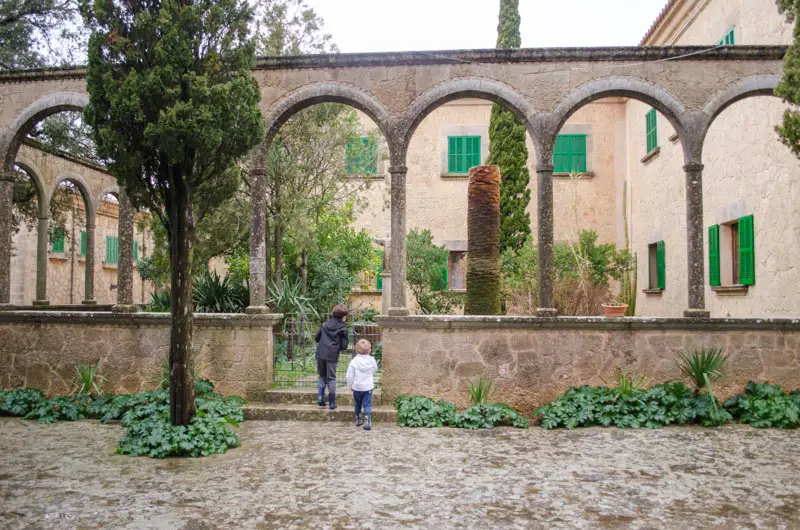
Many other monks followed his lead. A total of three monasteries were founded through the years on the table mountain in the interior of the island. All three monasteries, the hermit’s cave and a hidden tunnel system can be discovered on a single hike.
The Monastery Santuario Nostra Senyora de Cura is the most famous one and located on the top of the Randa Mountain. Since 1913, the sanctuary has been maintained by the Franciscan order. The complex is very easy to reach, even by car. In front of the monastery, there is a large parking lot, and inside, there is a restaurant and a small hotel with an attached hostel.
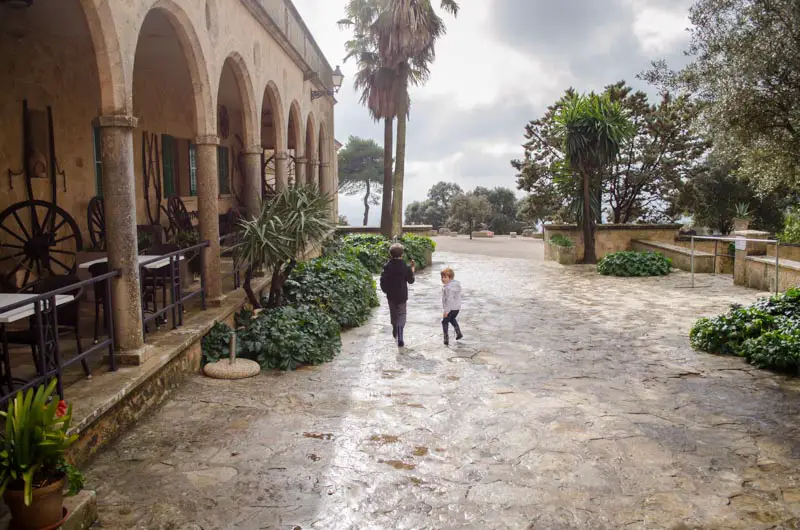
There are also picnic benches in the area. Somewhat hidden below the monastery, you’ll find a system of tunnels that once housed an ammunition depot. A small path leads you from the main road through lush vegetation to those tunnels.
The sanctuary Santuario Nostra Sra. de Gràcia was brought to life in the 15th century as a hermitage. A Franciscan monk decided to dedicate his life to God in the solitude of a huge cave on the south side of the mountain. With the help of another monk, he built a simple hermitage. After the death of the two founders, other Franciscan monks continued to expand it.
The Garcia Monastery can be reached by the same road. The junction is clearly marked and leads through an impressive stone gate. However, access to the monastery is currently not possible due to construction work.
The last of the thee monasteries is the Ermita de Sant Honorat, just a little above, was founded in the 14th century. The complex is so well-preserved that, despite numerous renovations, there is a large crucifix that is said to date from the time of its founding.
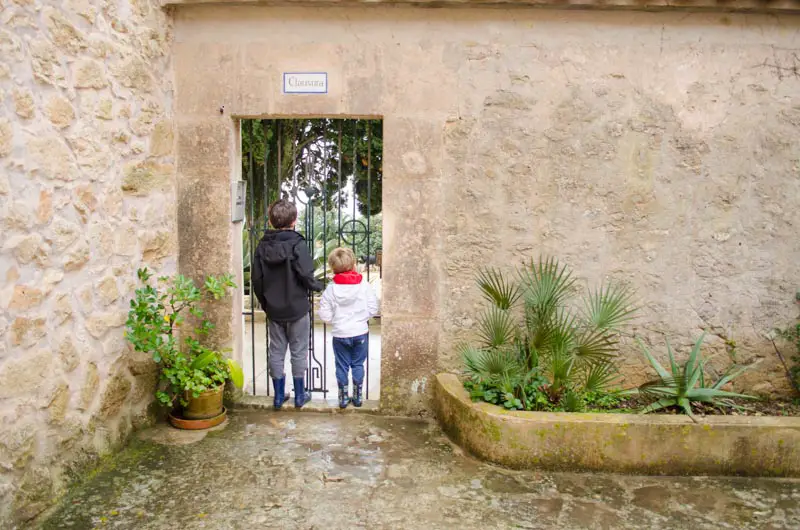
Also worth mentioning is a piece of land that is colloquially called the “Monk’s Garden”. However, the view of the southern tip of Mallorca is particularly impressive.
The Santuario de Lluc
Main article: Lluc Monastery – hiking, picnics, barbecue
Probably the most famous monastery on Mallorca is the Santuario de Lluc. There is hardly any tourist who does not visit it. Legend has it that an Arab boy named Lluc found a black statue of the Virgin Mary while herding sheep in the forest. Although the statue was taken to the nearest church, it kept turning up at the same place. This is why a shrine was built there to honor the wish of the Saint, to stay in the woods.
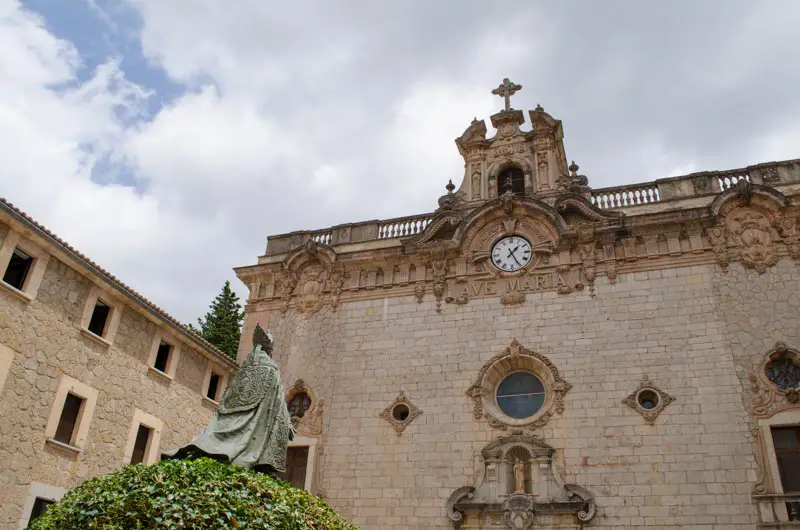
Today, the complex is so large that a trip there can fill an entire day. Next to the monastery is a boarding school with a focus on musical education, where the oldest children’s choir in Spain is trained. Just behind, you can visit a botanical garden, and in the summer, you can swim in a pool nestled between the mountains.
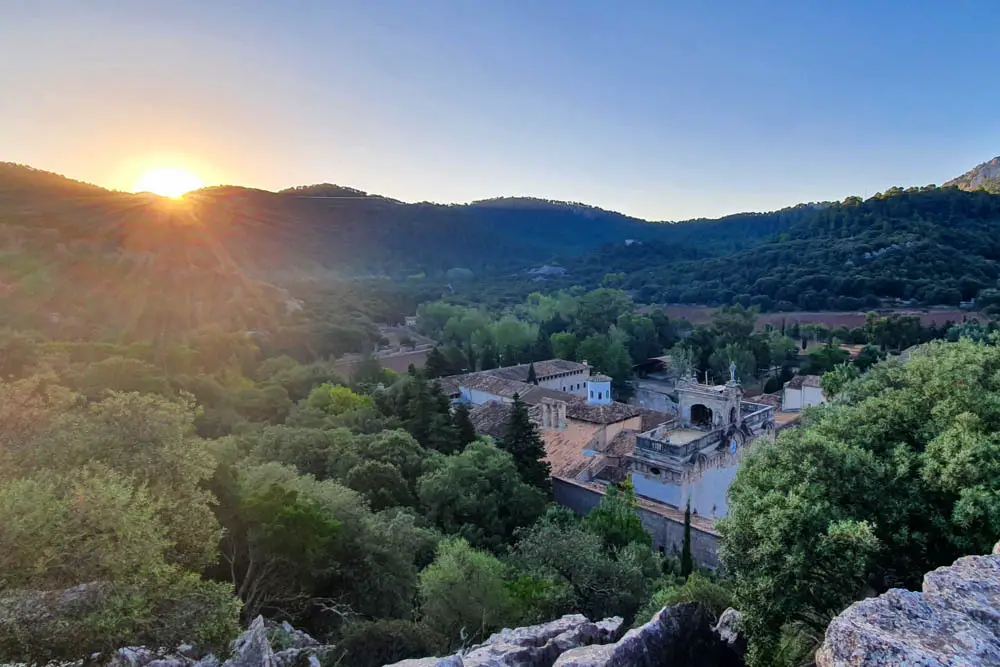
But there are also endless possibilities for hikers. Short tours lead to the mountain behind the monastery, while longer ones take you to a stone camel and a cave where people used to be buried.
Since one day is almost not sufficient to explore the monastery and the surrounding area, you have the option to stay overnight in the monastery or to camp at one of the legal campsites of Mallorca.
Santuario Sant Salvador (Felanitx)
Main article: The monastery of Sant Salvador in Felanitx
The monastery of Sant Salvador is located 509 meters above sea level on a mountain of the same name, just east of Felanitx. The first to settle here were some hermits in the 14th century. Legend has it that a shepherd (again) made a discovery. Water gushed out of the earth, and a light was seen. As the boy approached, he discovered a statue of the Virgin Mary in the damp earth. A chapel was built at the site of the discovery, which can still be found today, but a little below the actual monastery. From there, a path with 12 Stations of the Cross leads to the entrance of the monastery.
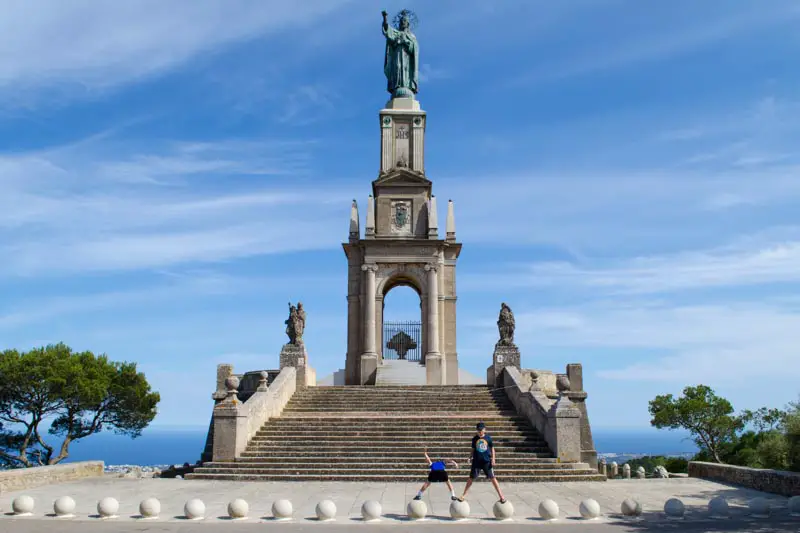
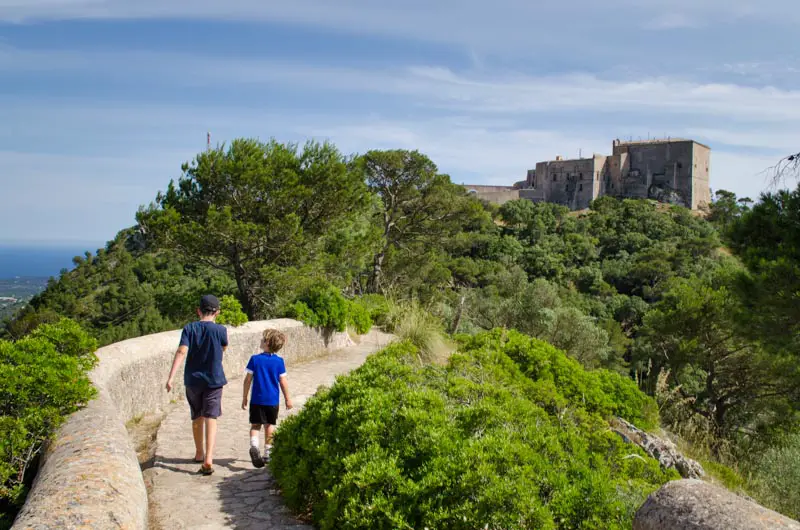
Around the monastery is a spacious picnic places with barbecue areas. There is a small hotel in the monastery.
Monesteri Miramar (Deià)
Main article: The Monastery Miramar
The former monastery of Miramar is a privileged place, high above the sea, with wide views over the sea. None other than Ramón Llull founded a missionary school here. Later, the estate was acquired by Archduke Luis Salvador of Austria, an important figure in Majorcan history, who restored the church that, by then, lay in ruins.
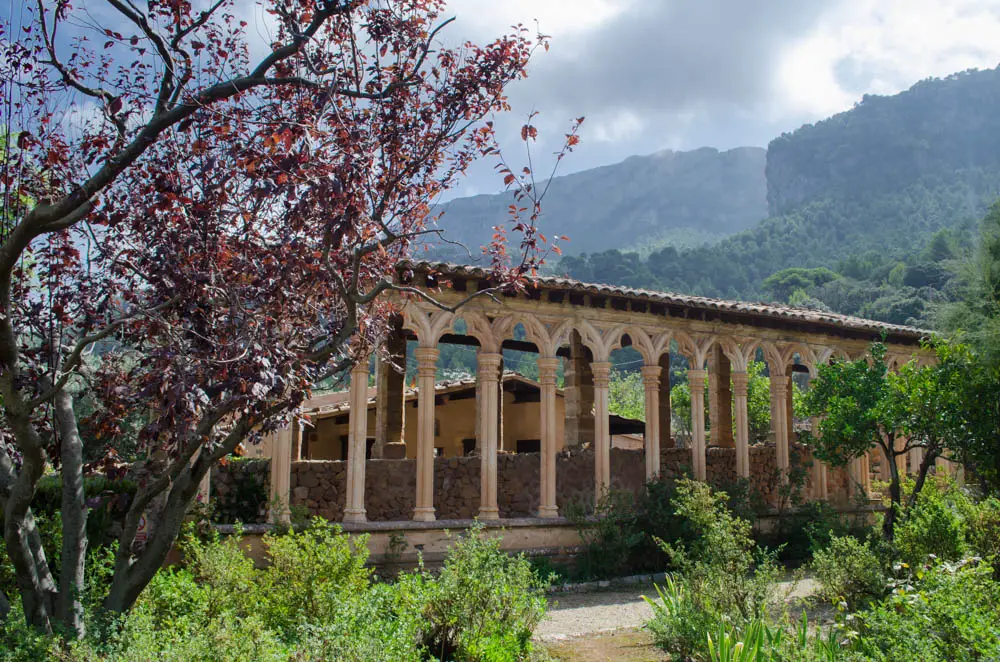
Luis Salvador is considered the first tourist of Mallorca and was deeply committed to nature and the environment. The monastery Miramar is suitable for a side trip, for those who visit the village of Deià and are looking for a little peace.
Monastery of Santa Maria de la Real (Palma)
Outside the ring road, not far from the stadium, you’ll find the monastery of Sant Bernat de la Real, formerly Santa Maria de la Real. Originally, in this place was the garden of an Arab governor. Legends say that the Catalan troops settled here for the reconquest of Mallorca.
A little later, the Cistercian monks lived here. Ramón Llull also stayed here for some time and wrote yet another book. Today, the Biblioteca Balear is located in the former monastery, which can be visited daily with or without guided tours.
Monestario de Santa Clara (Palma)
You find the convent of Santa Clara hidden and inconspicuous in the middle of the narrow streets of Palma. It is one of the cities oldest convents with nuns and one of the few active convents on the island.
If you think that the Poor Clares live in seclusion, you are only partly right. Although the nuns stay by themselves, they also run a small store selling homemade sweets and pastries. Especially during Christian holidays and festivals, the demand higher than the woman can handle.
The Santa Clara convent is one stop on our scavenger hunt through Palma.
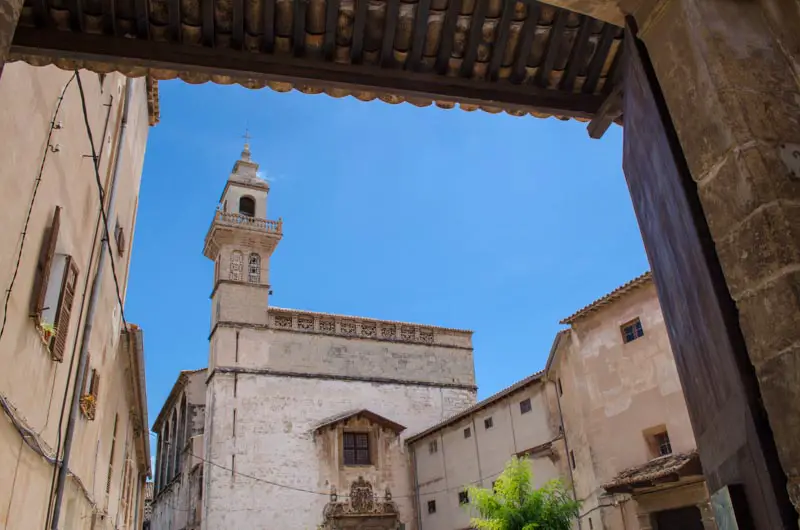
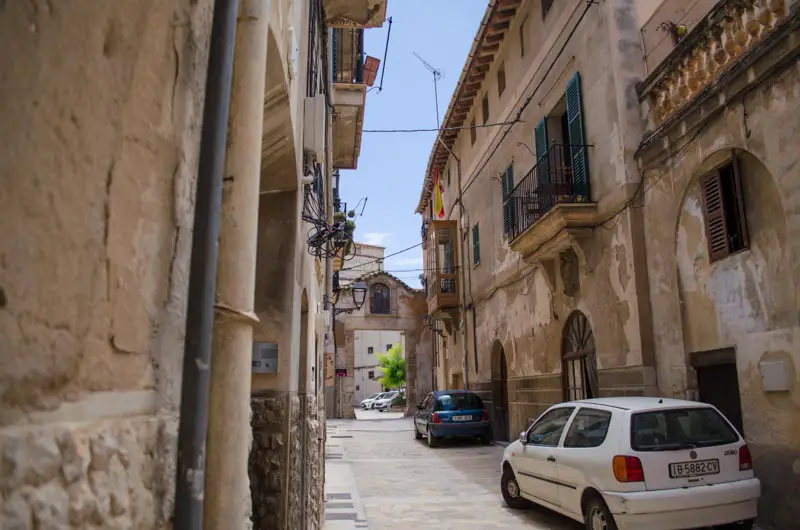
On small walks through Palma, a stop at the monastery is mandatory. For example, to try crespells or turrón. Or, in the summer, ice cream. Because in by now, the nuns have gone with time and started a small ice cream factory.
Opening hours: Monday to Saturday, 9 a.m. – 1 p.m., 4 – 5:30 p.m., Sunday 9 – 11:30 a.m., 4 – 6:30 p.m.
Santuari Monti-Sion (Porreres)
Monti-Sión Monastery is worth a visit for several reasons. For one, the view from the monastery hill is spectacular. For another, it is one of the often overlooked destinations. The tranquility on the mountain near Porreres is unreal. The monastery is unique in Mallorca for its pentagonal cloister. The path to the top is lined with seven Gothic columns.
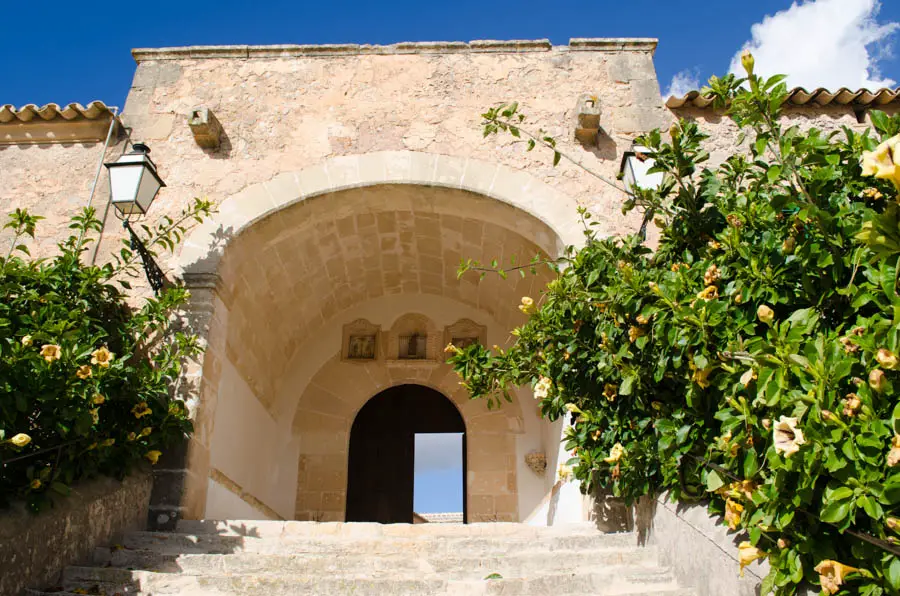
There is no real hiking trail to the monastery, but the access road is so sparsely traveled that it is quite possible to climb the monastery hill by foot from the town of Porreres.
The Carthusian monastery in Valldemossa
Main article: All sights in Valldemossa
The most famous residents of this monastery were Frédéric Chopin and George Sand, who spent a not so nice winter on Mallorca. The building as such is not necessarily the most impressive thing that Mallorca has to offer. The story behind it, however, is.
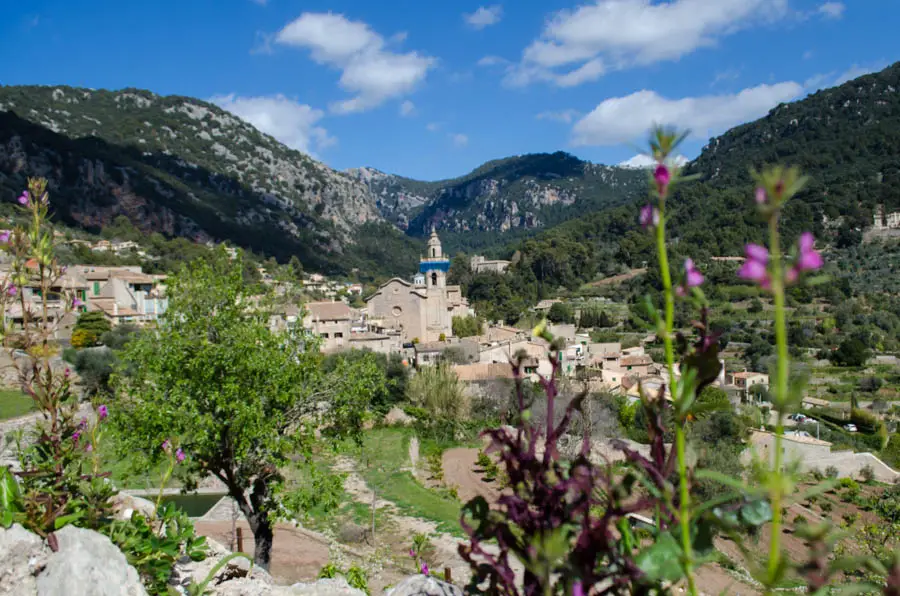
Visiting the Carthusian monastery in Valldemossa is not free. (Tickets are available here). If you want to enter the monastery cells where Chopin and Sand (supposedly) lived, you have to pay an additional fee to the regular entrance fee.
Hiking to the hermitages of Mallorca
Your children are too active to walk devoutly through churches and monasteries? I know, mine are too. There are certainly exceptions, but often religious sites are not necessarily child-friendly. If you don’t want to miss out on the monasteries of Mallorca, but want to get your kids out and about while you’re at it, I suggest a few hikes that lead to hermitages.
Hermitage of Betlem
Main article: Ermita de Betlem
The hermitage in the municipality of Artà was built on the ruins of an Arab estate. The abandoned complex can be reached either by car via an asphalt road, or – a bit more adventurous – from the fishermen’s village of Betlem.
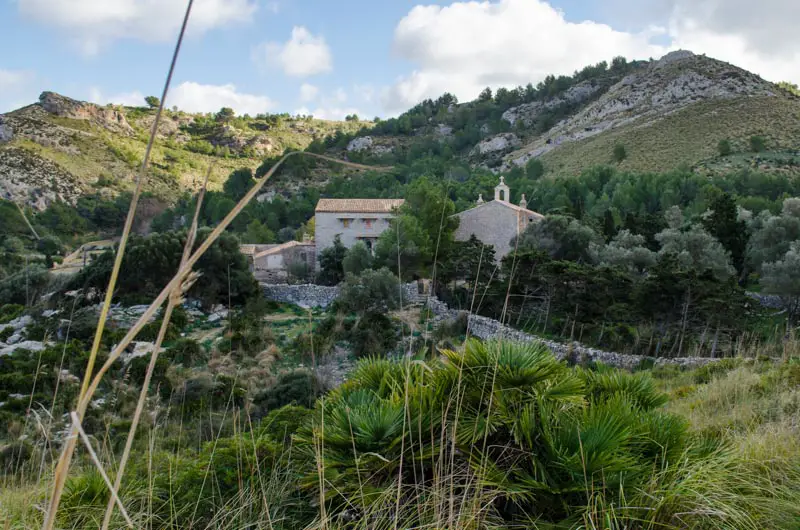
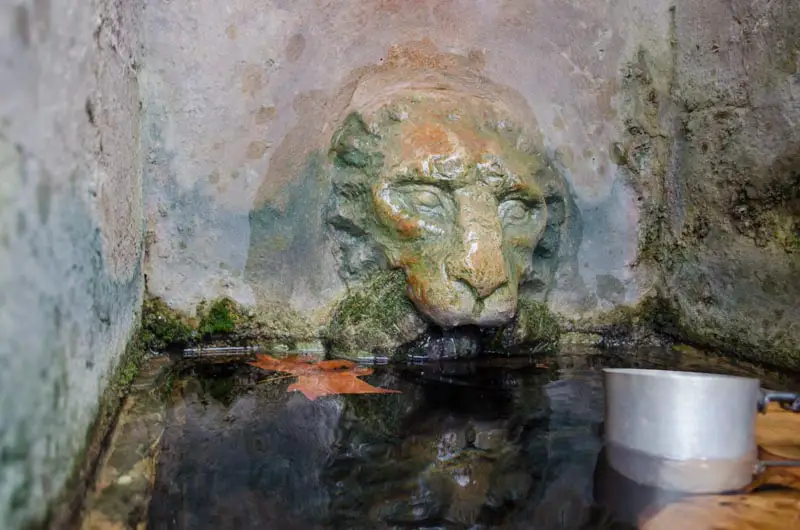
The route takes you past dams and caves, through a gorge, to a spring with a lion’s head and up to a mountain ridge with a panoramic view.
The chapel La Consolación (Santanyi)
Main article: Santuari de Consolació
This former hermitage gives more the impression of being a fortress than a monastery: thick walls protect the small chapel inside. In the past, the area was frequently visited by marauding pirates. [> Pirates of Mallorca]
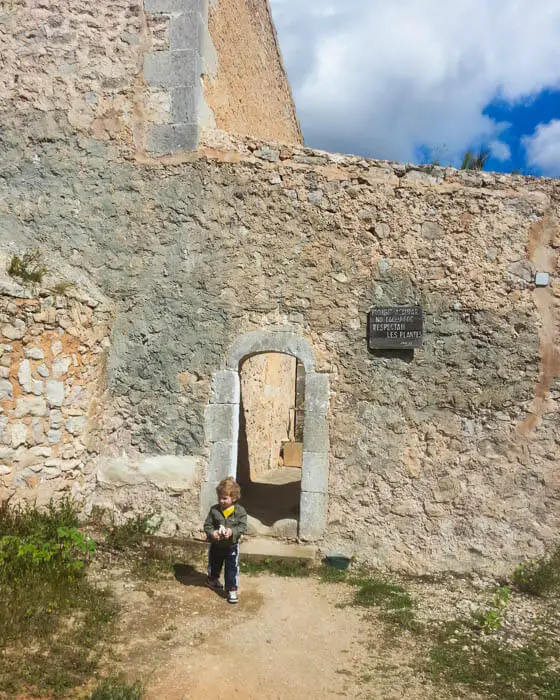
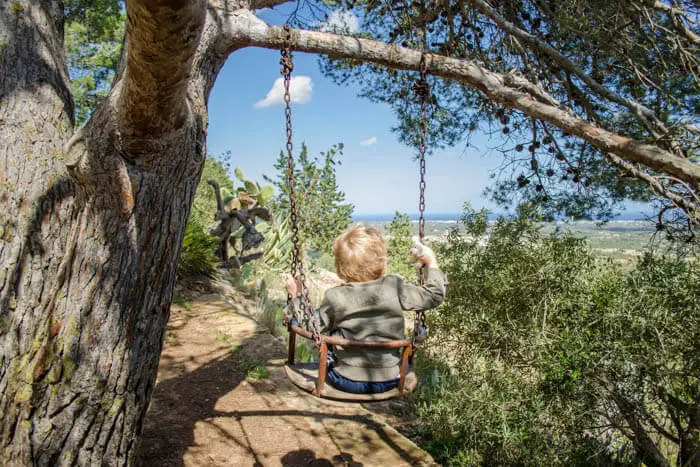
To get to the mountain with the small monastery complex, you can send your children up a steep staircase, or walk through the forest. In the monastery garden there are many stone picnic tables and a swing with sea view.
The monastery of La Trapa (Andratx)
Main article: La Trapa in Sant Elm
La Trapa was founded in 1810 as a monastery and mountain farm by the Trappist monks, in a difficult a valley near Sant Elm with difficult access. The monks, who fled the French Revolution, cultivated on the barren land and were able to live self-sufficiently for many years until they were expropriated during secularization and expelled from the island. In order to avoid construction projects, the environmental organization GOB acquired the land through donations.
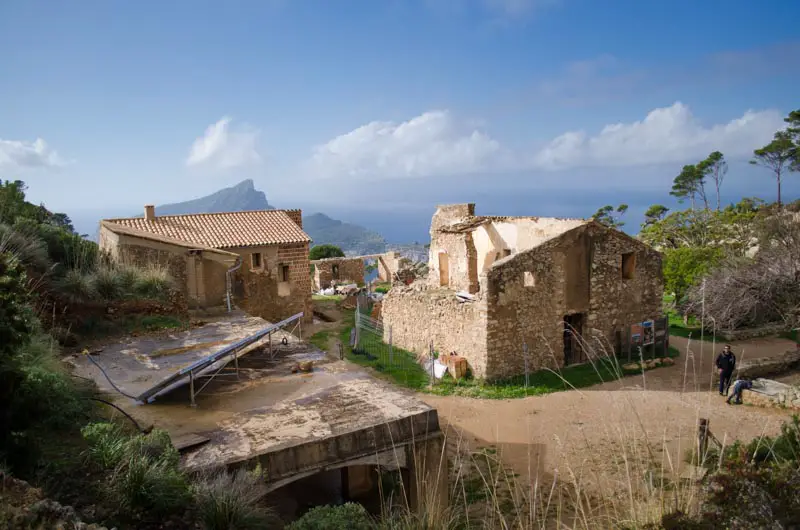
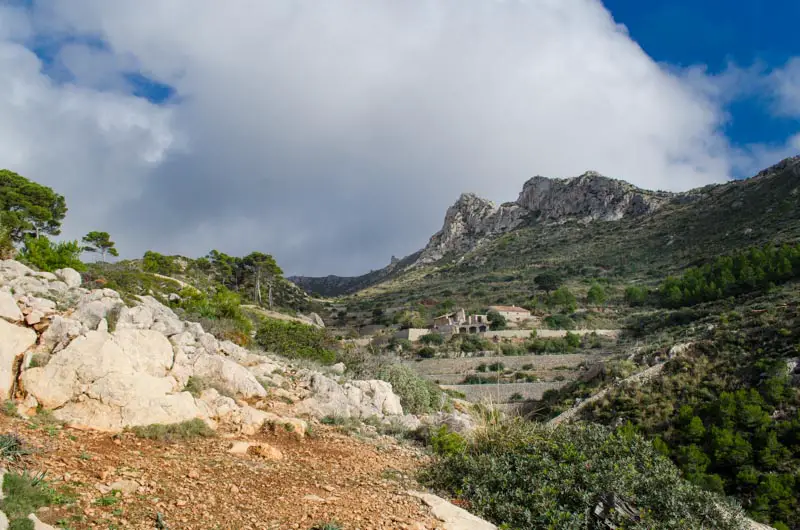
The tour to the ruins of the former monastery is somewhat demanding. Either it leads over a short path along the precipice of the very steep coast, or in a long serpentine up the mountain and down again.
Puig de Maria (Pollença)
Main article: Monestary Puig de Maria
The trip to the sanctuary on the mountain Puig de Maria is very easy. It leads over an old, paved pilgrimage path up the mountain. There you find unique views of the northeast coast and the opportunity to picnic and barbecue. If you really like it, you can also spend the night in the old monastery cells.
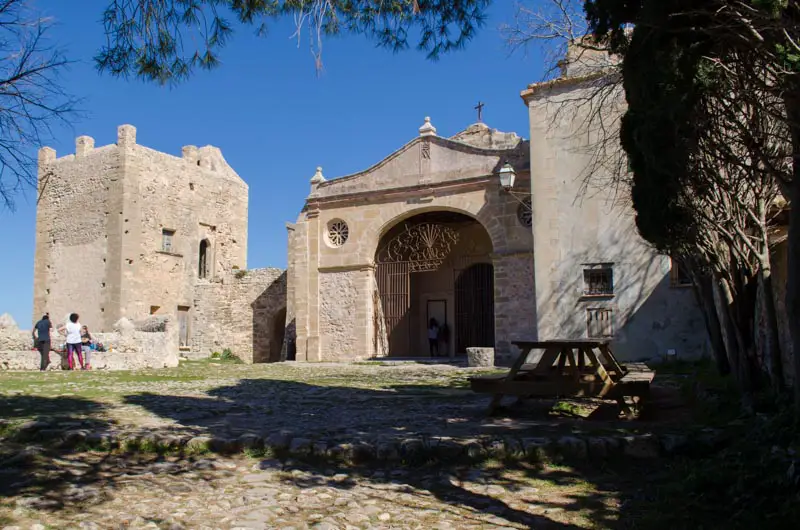
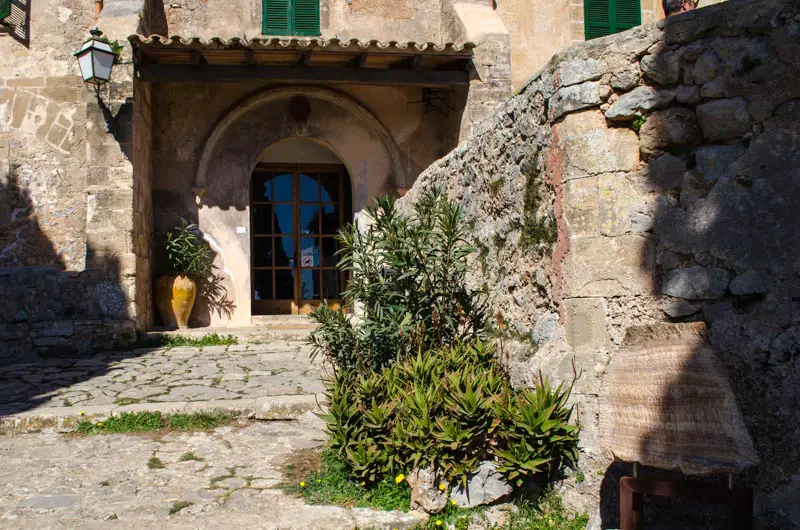
The monastery mountain can only be reached through a short walk. This starts on the outskirts of Pollença and leads partly over an asphalt road. The last section, however, is covered with somewhat slippery cobber stones. This part is the old pilgrim path.
The castle of Alaró
Main article: Castle of Alaró
A monastery? No. The Castell of Alaró is, of course, primarily known as a fortress. But there was once a hermitage here too, the Ermita de Nostra Senyora del Refugi. It was built after pilgrims climbed the mountain to ask for rain for Mallorca in the midst of a great drought. It rained and to show their gratitude, the people built a small shrine.
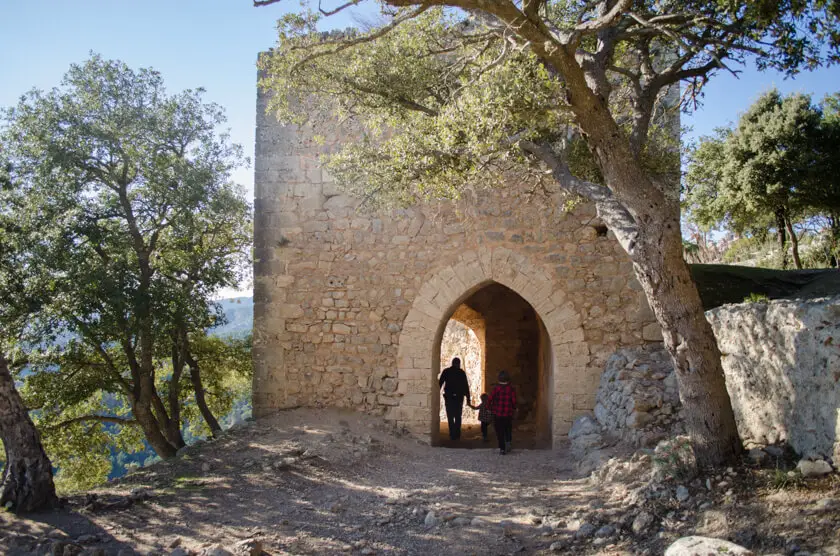
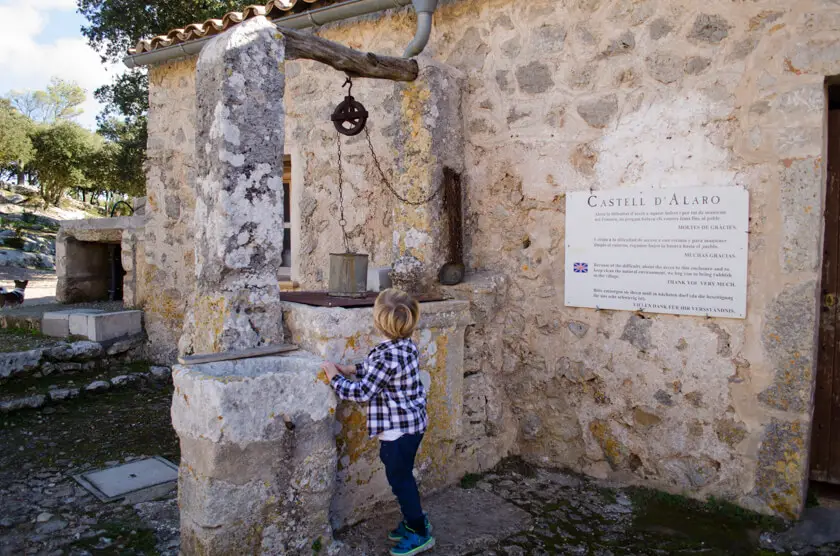
The chapel can be visited during a visit to the castle. The tour is a classic among Mallorcans and can be varied according to condition and age of the people who participate. Also, there is the possibility of an overnight stay.
Other excursions to small hermitages
Eventually, any hermitage can be part of an excursion. However, it would go beyond the scope if I would present them all in detail. Therefore, ?m only going to summarize them and link to further information.
Ermita de Bonany
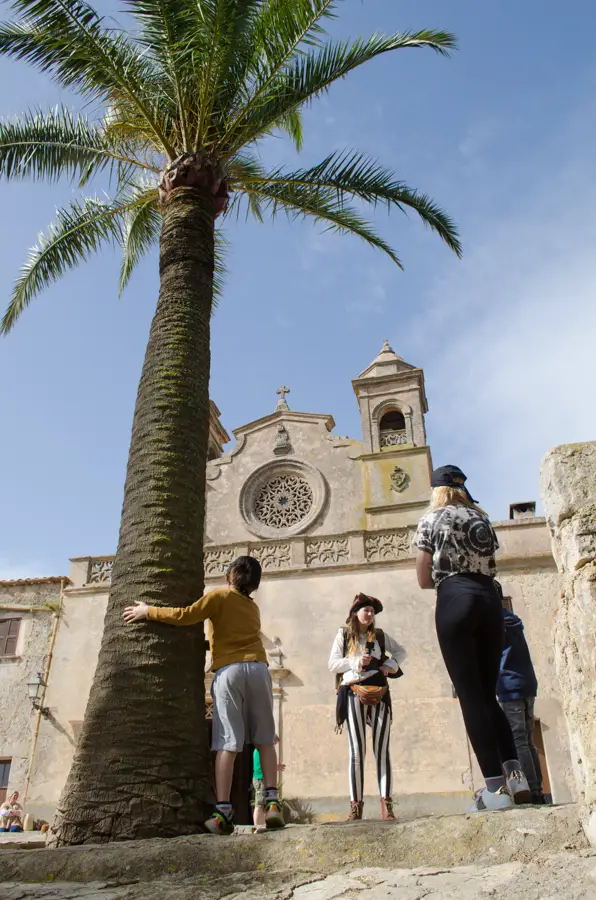
Small church on a hill in the outskirts of Petra. The outdoor facilities are well suited for a picnic. There is both a road and a hiking trail.
Ermita de Bellver
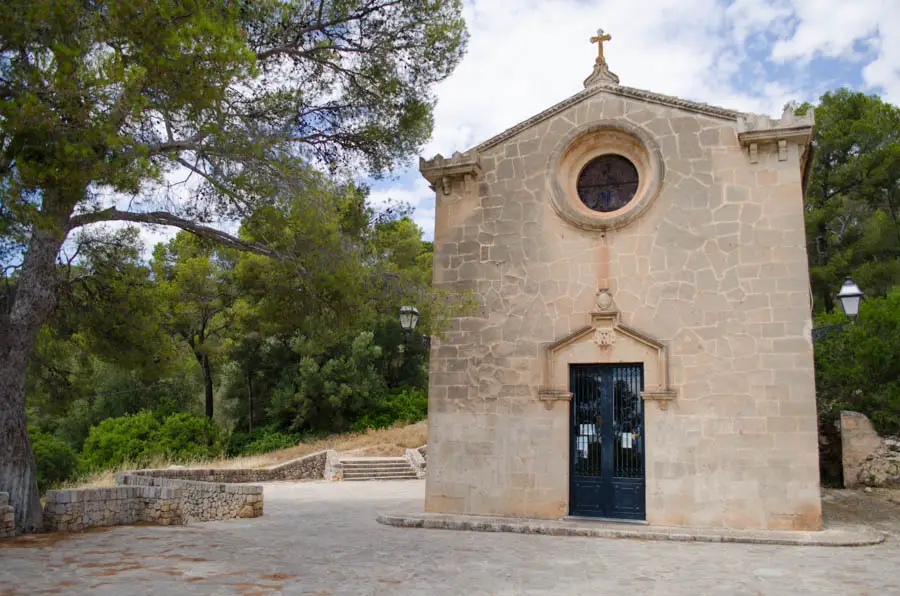
Small chapel below Bellver Castle overlooking the port and the cathedral.
Ermita Cristo Rei
A very dilapidated but interesting ruin near Selva.
Ermita de Sa Cova de Sant Marti
Close to Port d’Alcúdia, the oldest cave sanctuary of Mallorca. It is said that it served as catacombs in the Roman Pol-lentia.
Ermita de l’Inmaculada
This hermitage is located above Sóller in a forest and its construction looks like a small witch’s house.
Ermita de la Santísima Trinidad
Hiking Trail: Ermita de la Santísima Trinidad
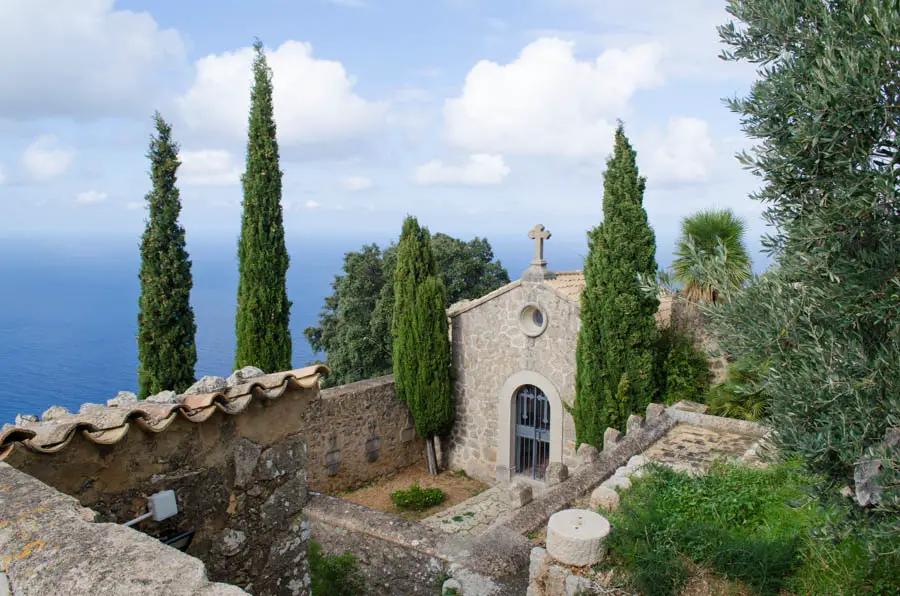
This small church is located near Valldemossa, right by the sea. The views are spectacular.
Ermita de Capdepera
Main article: The castle of Capdepera
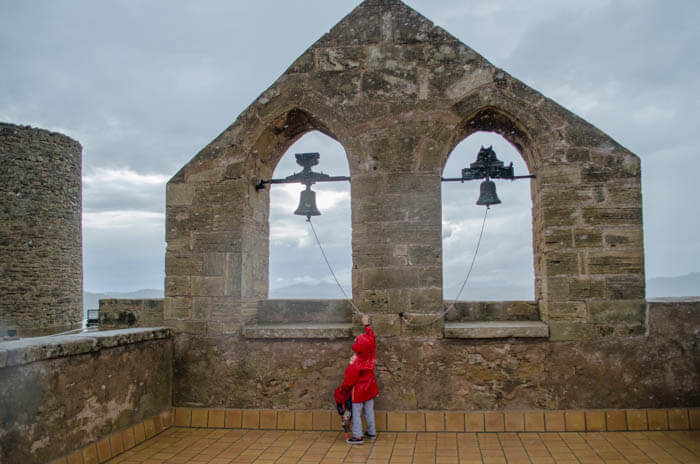
Here, too, the small chapel is hidden within thick walls of an ancient castle. The former hermitage is located on the railing of the castle of Capdepera. Highlight: You can ring the bells.
Ermita de Victoria
The hermitage on the Victoria Peninsula serves as a starting point for many hikes near Alcúdia. You can have lunch here in the restaurant or spend the night in the hostel.
Ermita de Sant Miquel
Main article: The legend of the Ermita Sant Miquel
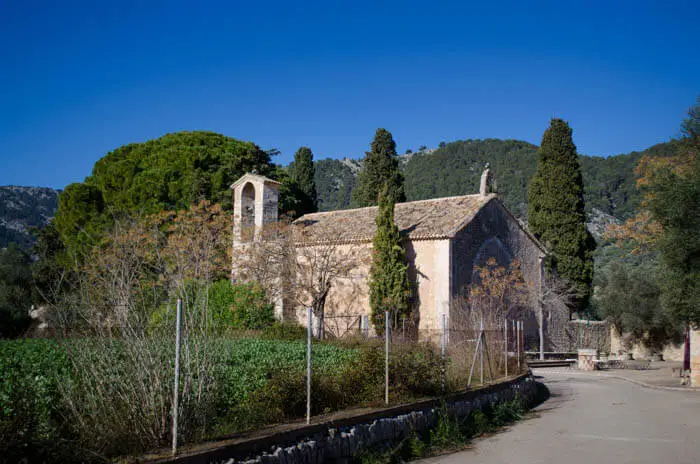
The former hermitage is the oldest parish church in Mallorca. It is located very close to the caves of Campanet and the springs of Ses Fonts Ufanes.
Ermita Sant Salvador in Artà
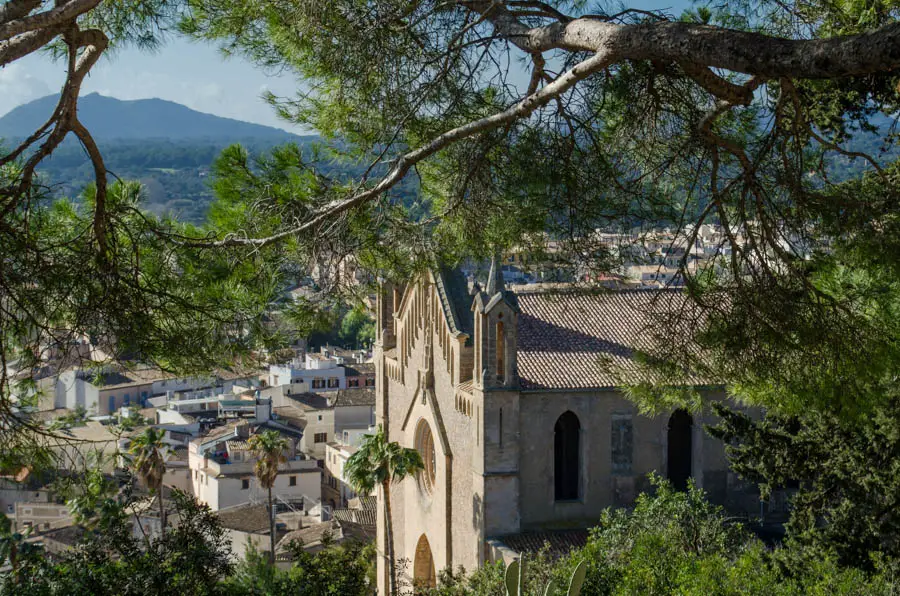
This monastery complex is situated on top of the small town of Artà.
Ermita de Santa Llucia in Manacor
Small church on the mountain in the outskirts of Manacor.
Cova de s’Ermita Guillem
The cave where a hermit is said to have lived in the forest of Son Moragues is not far away from the popular hiking trail Camí de s’Arxiduc.
Ermita del Calvari in Felanitx
Find the trail: Among the information to Felanitx
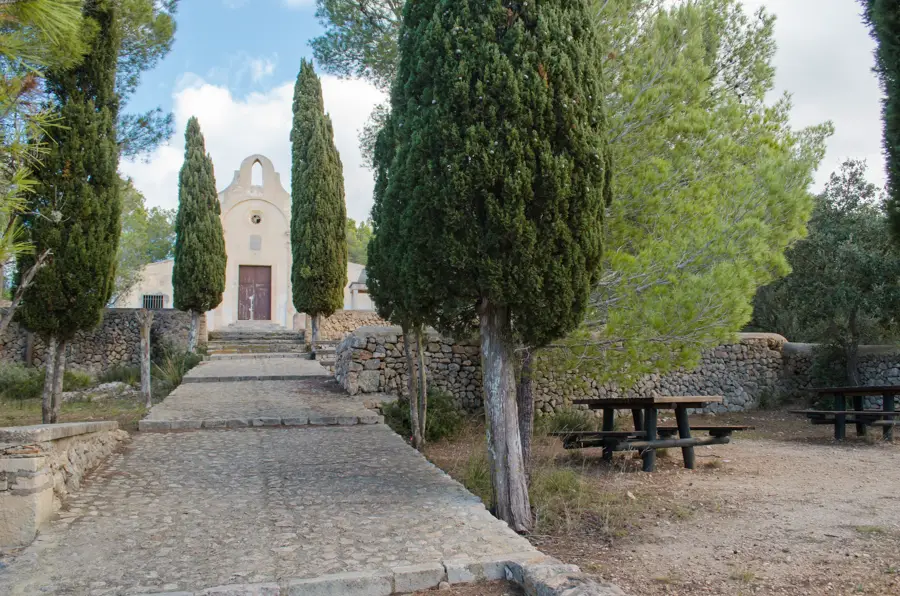
Small chapel with nice outdoor area in the outskirts of the small town of Felanitx. An easy trail leads from the town up the hill. Experienced hikers can start here to hike to the monastery on the mountain Sant Salvador.
Hermitage Sa Mola de Tuent
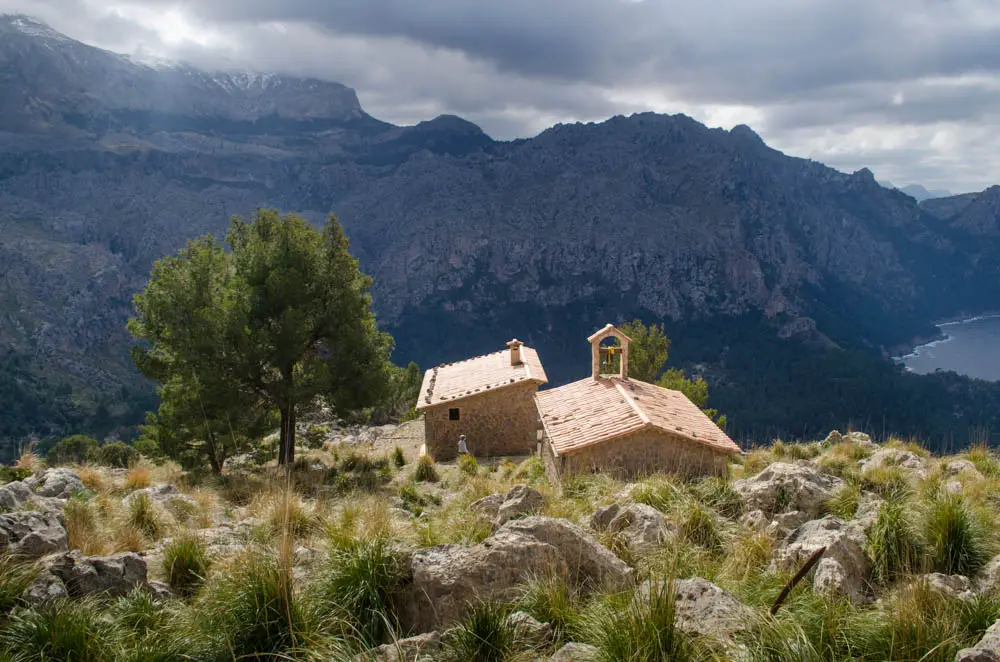
Cala Tuent is a secluded beach located on the northern coast near Sa Calobra. Positioned above the bay is an ancient 16th-century watchtower. Adjacent to it stands an abandoned chapel, known by the name Sa Mola de Tuent.
Overnight stays at the monasteries of Mallorca
The following monasteries, sanctuaries, and hermitages offer the possibility of overnight stay. In some cases, as in the monastery of Lluc and the monastery of San Salvador, with quite a lot of luxuries. In other places it is more modest. Since some monasteries have already been mentioned above, I will only list them here. An overview with the data on contact options and reservations is available in the article alternative accommodations or, if available, the article of the monastery itself.
- Ermita la Victoria
- Santuario de Lluc
- Santuario de Nuestra Señora de Cura
- Ermita de Bonany
- Santuario del Puig de Maria
- Sa Capelleta de S’Olivar
- Monasterio de Santa Llucia
- Santuario de Monti-Sion
- Santuario del Puig de Sant Salvador
Read more
Warst du schon einmal hier? Teile anderen Lesern deine Erfahrung gerne in den Kommentaren weiter unten mit!
Lust auf mehr Mallorca-Tipps? Mit der Anmeldung zum Newsletter erhältst du fünf Tage lang je einen Geheimtipp der Insel direkt in deine Mailbox.
Want more recommendations like this? Check out more than 100 day trips and excursions on Mallorca.
Planning your holiday on Mallorca:
Book your Flight here
Great Rental Car Offers

